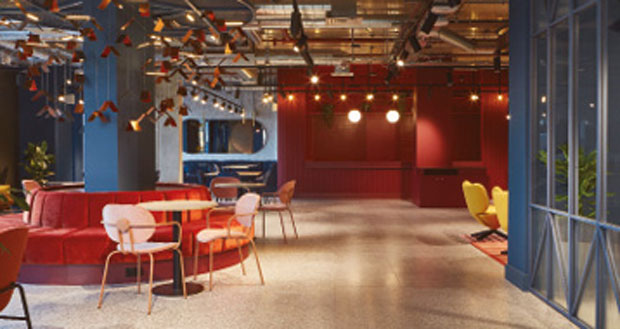 Trifle* delivers spaces for a range of companies and brands with a focus on human-centric design. Founder Emma Morley asks, what are UK companies failing to do to attract and retain talent and as workspace designers, what can we do to help?
Trifle* delivers spaces for a range of companies and brands with a focus on human-centric design. Founder Emma Morley asks, what are UK companies failing to do to attract and retain talent and as workspace designers, what can we do to help?
It’s hardly surprising that we are facing an enormous mental and physical health crisis. More than half of adults say their mental health has worsened during the pandemic (Mind) and 1.3 million people in the UK are experiencing long COVID (ONS). Twenty to twenty one per cent of UK adults (14 million) are disabled (Scope), that is 4.4 million in the workplace; It is estimated that approximately 70 per cent of these disabilities are invisible.
Many workers, especially those with health challenges, are reluctant to depart from the security of their homes to commute into places of work, more than they absolutely need to and so with this in mind, it is key that designers of workspaces, look carefully at how the space in which we inhabit can not only nurture its workers – but be part of a strategy to encourage, as well as retain employees.
ARCHITECTURE IMPACT
Architecture has the ability to impact how we feel, behave and even how we recover from illness. Thoughtfully designed spaces can be therapeutic to the extent that they can positively affect our wellbeing. Workspaces can and should comfort, nurture, soothe and restore – and by starting the design process with ‘people-first’ and ensuring that means ‘all people’, we can begin to create spaces that feel more considered and caring, not only to existing but also, to potential employees.
The neurodivergent population is now estimated at between 30-40 per cent of the population. Neurodiverse individuals often possess incredible and unique talents and skills. Creating an inclusive environment can empower them to reach their full potential, however, identifying and implementing can be challenging. As a partially deaf person (I have Menieres disease which is a vestibular disorder, so I am now almost deaf in one ear) I also suffer with hyperacusis (sensitivity to sounds) and am not alone – approximately 21 per cent of the population suffer with this. With this in mind, the acoustic treatment of our own new workspace for example, has taken on a new importance.
The process of designing a workspace should be inclusive from the off and explore ways of serving a full spectrum of people who make up a diverse market, creating varied solutions, rather than a ‘one size fits all’ approach. Good design must consider needs which extend past those of the perceived ‘average’ or ‘typical’ user of any space and proposed schemes must now focus on expectations from hybrid workers as well as mental and physical health considerations.
- Community engagement > Give a wide variety of people the opportunity to speak up about how they want their workspace future to be shaped. Be willing to listen, be flexible and adapt over time, as this is key to understanding the needs of those who may not be able to speak up for themselves.
- Acoustic treatment > Sound is one of the greatest challenges in modern workspaces, especially for those with neurodiverse and other health challenges.
- Lighting > Sometimes, neurodivergent people and others with invisible health issues can be highly sensitive to harsh lighting and contrasting tones. It may be helpful to implement areas of softer lighting and ensure democratic access to natural light, as opposed to bright overhead lighting only.
- Sustainable & natural materials > Biophilic design theories are long proven in supporting the health of inhabitants, so go for that greenery. The use of sustainable finishes and furniture, and nature-influenced colour palettes can all be hugely beneficial. Always seek opportunities to bring the outside in.
- Wayfinding and Communication > Underpinning all communications and strategy with a tone of wellbeing, trust and openness is critical for businesses returning to the office and implementing hybrid (or similar) models. Signage and touch points throughout a space can tell us we are cared for, while enabling a positive user experience across any space.
- Technology > Should be seamless and consistent, so that it is user friendly for all types of workers. Spaces should be designed to accommodate both office based staff as well as those connecting remotely.
- Choice and Variety > Having choice about where to work during the day, has been proven to be extremely empowering and can have a marked impact on the mental health of employees. Areas for focus and quiet, as well as areas where you can be part of the energy of an organisation, are of equal importance. It is usual for us to build in wellbeing rooms, meditation and prayer areas, and multifunctional spaces that work for pilates, yoga classes or social gatherings.
Although high functioning work environments cannot address every issue, they can and should be attentive to our health. Not as tokenism or as a ‘perk. At a time when attracting and retaining talent, and maintaining happy teams is key to a thriving business, it may never have been so critical to create workspaces that demonstrate that they truly care.





